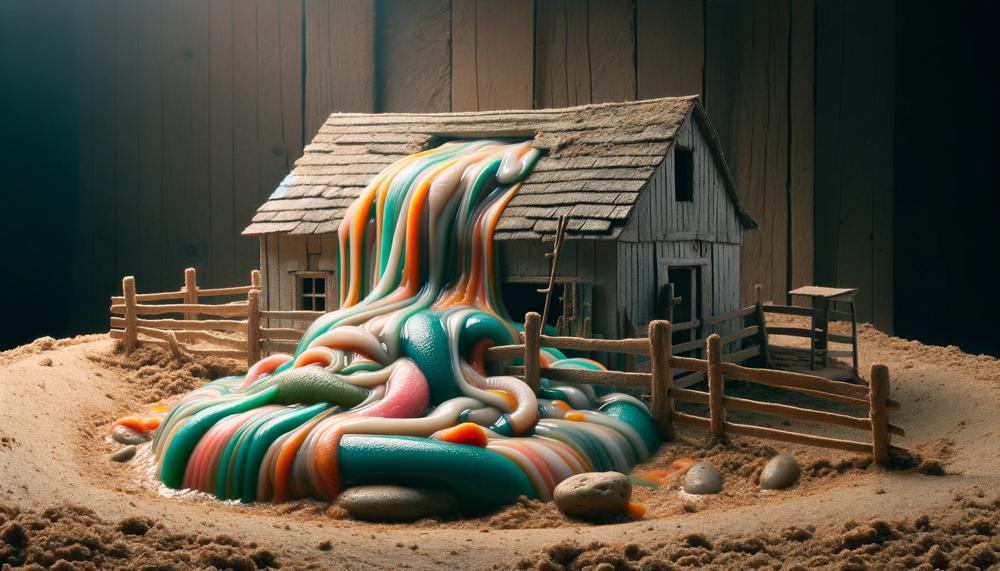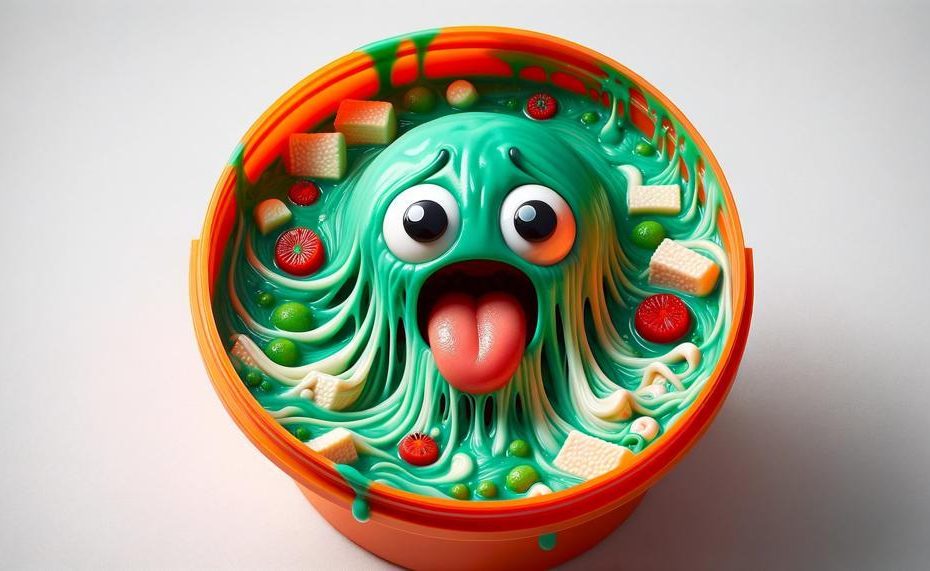Within the whirling world of crafts and do-it-yourself endeavors, slime has a soft, cozy spot in our hearts. Millions of people have enjoyed this goop, from inquisitive young children to grown-ups seeking a tactile diversion.
The question is, however, what will happen to this sticky companion’s environmentally beneficial future when the first excitement wears off? It’s not as simple as throwing it in the trash to find the solution.
Today, we’re delving deeply into the practice of giving your slime away ethically so that our sparkling pleasures don’t end up as a burden on the environment.
So, how to dispose of slime properly?
Slime can be disposed of in household waste. You can throw it in a waste container, or add a mixture of vinegar and lemon juice to it, wait for the ingredients to float, and then peel and throw them away. The remaining mixture can be taken to a hazardous waste treatment center.
You should keep slime away from pets because borax is toxic to animals.
Some recommend repurposing or reusing slime instead of throwing it in the trash. You can use slime to make suncatchers, sculptures, glitter jars, paintings, or window clings.
Let’s make sure our slimy fun doesn’t stick around longer than it should, for the sake of our planet.
Contents
Understanding Slime
Understanding the nitty-gritty of slime is quite the adventure. It’s like a magic potion made from everyday stuff lying around the house. The heart of slime lies in its key ingredients: PVA glue and a nifty thing called a slime activator, which could be borax or even a simple saline solution.
When these two dance together, they create a spectacular show – a chemical reaction known as cross-linking, turning the mixture into a fascinating non-Newtonian fluid. This means slime can act like both a solid and a liquid, depending on how you treat it. It’s like it’s got a mind of its own.
| Ingredient | Role in Slime | Alternative Options |
| PVA Glue | Base of the slime, providing the ‘gooey’ texture | Cornstarch and water (for a more eco-friendly version) |
| Slime Activator (Borax, Saline Solution) | Triggers the chemical reaction to form slime | Baking soda and contact lens solution |
Problems with Slime
Disposing of slime, a popular plaything for the young and the young at heart, involves a tad more thought than one might initially reckon.
This squishy substance, while a source of endless amusement, becomes a bit of a sticky wicket when it’s time to say goodbye.
Sticking Points in Slime Disposal
| Issue | Description | Consequence |
| Environmental Harm | Slime’s non-biodegradable nature means it lingers in landfills, contributing to pollution. | Long-term environmental degradation. |
| Plumbing Havoc | Flushing slime down the loo or sink invites clogs and potential damage. | Costly repairs and plumbing nightmares. |
| Surface Damage | Improper disposal methods can lead to slime remnants on fabrics and hard surfaces. | Stubborn stains and cleanup hassles. |
| Ecosystem Disruption | When slime finds its way into natural habitats, it can harm local flora and fauna. | Adverse effects on biodiversity and ecosystem health. |
Crafty Solutions for Slime Farewells
Averting the aforementioned fiascos calls for a bit of ingenuity and a responsible approach to disposal:
- Seal it Tight: Encase the slime in a plastic bag before binning it, ensuring it’s a snug fit in the rubbish, away from nature’s reach.
- Dry Out to Bid Adieu: Letting slime air dry reduces its volume and stickiness, making it less of a menace in the waste stream.
- Craft Your Own: Opt for homemade, biodegradable slime concoctions, marrying fun with eco-consciousness.
For those unfortunate moments when slime declares war on fabrics or tresses, a dab of vinegar or a sprinkle of baking soda might just broker peace, breaking down the slime for easier removal.
How To Dispose of Slime
Disposing of slime in a way that’s kind to our planet requires a bit of know-how and creativity. Here’s how you can tackle it without causing harm to Mother Nature or clogging up the drains.
| Method | Description | Benefits |
| Let It Dry | Allow slime to air dry until solid. | Easily disposed of in trash. |
| Seal and Bin | Encase in a plastic bag before binning. | Prevents sticking to other waste. |
| Homemade Solutions | Use vinegar, baking soda, or ice. | Eco-friendly and simple. |
| Biodegradable Slime | Make slime using cornstarch and natural ingredients. | Safe for the environment. |
| Professional Assistance | Seek help for difficult disposals. | Avoids environmental damage. |
Is Slime Biodegradable?
Not quite. The popular slime that children and adults alike revel in – usually concocted from glue, water, and either borax, baking soda, or contact solution – doesn’t break down easily in nature.
This means it’s a no-go for being eco-friendly or safely blending back into the earth without a trace.
Understanding Slime’s Impact
Slime’s sticky fun comes with a less amusing side when it’s time for disposal. Chucking it incorrectly can lead to not just environmental woes but also blockages in plumbing systems and unsightly messes.
With a bit of savvy, disposing of slime doesn’t have to be a headache or a heartache for Mother Nature.
Smart Disposal Methods
| Method | Procedure | Eco-friendly? |
| Seal and Bin | Encase in a sealable plastic bag and bin it. | No, but prevents environmental exposure. |
| Dry Out | Allow to dry completely before disposal. | No, but reduces mess. |
| Homemade Biodegradable Slime | Use cornstarch, water, and food colouring. | Yes |
Extra Tips for the Sticky Situations
Got slime on your favourite jumper or tangled in your hair? Fret not. Apply ice cubes to harden and then scrape off the slime from clothes. For hair, a concoction of conditioner and apple cider vinegar works wonders in loosening its grip.
The Bottom Line
While traditional slime isn’t a friend to the environment, knowing how to dispose of or even make an alternative, biodegradable version can ease your eco-conscience.
Is Slime Recyclable?
Slime is considered non-recyclable waste due to its unique chemical composition and sticky texture, which are incompatible with standard recycling processes.
It’s made from synthetic materials that can’t be broken down or repurposed alongside traditional recyclables like paper, plastics, or glass.
Disposing of Slime: Smart Ways to Do It
While you can’t chuck slime into the recycling bin, there are savvy methods to dispose of it responsibly:
- Donation: Schools or local community centers might accept it for arts and crafts.
- Trash: As a last resort, slime should be placed in the general waste bin.
Understanding Slime’s Impact
| Attribute | Details | Notes |
| Recyclability | Non-recyclable | Due to its synthetic makeup and consistency. |
| Environmentally Friendly? | No | Its disposal can contribute to pollution if not done carefully. |
| Safe Disposal Methods | Donation, General Waste | Choosing the most responsible option available. |
How To Dispose of Homemade Slime?
Disposing of homemade slime needs to be done with care to avoid plumbing disasters and minimize environmental impact. Here’s a straightforward guide to ensure you’re doing it both safely and effectively.
Safe Disposal Methods
| Method | Description | Benefits |
|---|---|---|
| Seal and Bin | Encase the slime in a sealable plastic bag and dispose of it in your household trash. | Prevents plumbing blockages and environmental harm. |
| Dry Out and Dispose | Allow the slime to dry out completely before putting it into the trash. | Makes the slime less messy and easier to handle. |
| Household Dissolution | Use vinegar or baking soda to break down the slime before disposal. | Eco-friendly and safe for most plumbing systems. |
| Freezing | Freeze the slime, making it easier to peel off from surfaces for disposal. | Effective for cleaning up small amounts or residues. |
| Create Biodegradable Slime | Opt for slime recipes using cornstarch, water, and food coloring for an eco-friendly option. | Minimizes environmental impact upon disposal. |
The Best Biodegradable Slime Recipe
To concoct The Best Biodegradable Slime Recipe, one must delve into the realm of eco-conscious materials, ensuring the blend not only entertains but also respects our planet.
This guide illuminates the path to creating such a marvel, with an emphasis on the simplicity of ingredients and the diligence in disposal.
Ingredients Required:
- Flaxseed: The backbone of our slime, providing a natural, viscous base.
- Corn Starch: The thickener, allowing us to finesse the texture to perfection.
- Water: The catalyst, transforming our solids into a delightful goo.
- Biodegradable Glitter/Tapioca Pearls: For those craving a dash of whimsy, these add sparkle and texture without betraying our eco-ethos.
- Natural Food Coloring: For a splash of color, derived straight from the bounty of nature.
Preparation Table:
| Ingredient | Quantity | Role |
| Flaxseed | 1 cup | Base |
| Corn Starch | Start with 2 tablespoons, adjust for thickness | Thickener |
| Water | 2 cups | Solvent |
| Biodegradable Glitter/Tapioca Pearls (Optional) | To taste | Decoration |
| Natural Food Coloring (Optional) | To desired color intensity | Coloring |
Proper Disposal:
Once the life cycle of your biodegradable slime reaches its end, or you wish to return to the simplicity of less gooey pastimes, consider the following disposal method to keep in step with our eco-friendly theme:
- Compost: Given the organic nature of our slime’s constituents, a compost heap would gladly welcome it. Here, it breaks down, contributing to the cycle of life, rather than languishing in landfill.
- Refuse Bin: If composting isn’t an option, disposing of it in the refuse bin is acceptable. While not ideal, it ensures that the slime does not clog plumbing or harm aquatic life.
In crafting The Best Biodegradable Slime Recipe, we weave together the joys of tactile play with the reverence for our environment.
Tips and Tricks for Slime Disposal
Disposing of slime, a favourite squishy companion of kids and adults alike, demands a bit of nous to avert plumbing woes and environmental mishaps.
Safe Disposal Methods
| Method | Details | Why It Works |
| Seal and Bin | Encase the slime in a plastic bag before chucking it in the bin. | Prevents slime from sticking to other waste, reducing environmental risk. |
| Air Dry | Spread out the slime and let it dry completely before disposal. | Dried slime is less sticky and easier to dispose of without clogging bins. |
| Direct Toss | Throw slime directly into the trash. | Quick and simple, suitable for small quantities of slime. |

Eco-Friendly Disposal
Biodegradable Slime: Opt for slime made from cornstarch and water. This eco-friendly variant lessens the guilt of disposal and is kinder to Mother Earth.
Cleanup Tips
- Vinegar Magic: Vinegar dissolves slime, making cleanup on surfaces a breeze.
- Freeze It: Pop slime-covered items into the freezer. Once frozen, peel off the slime.
- Conditioner or Ice: For slime entangled in hair, apply conditioner or rub ice cubes on the area to ease removal.
Conclusion
It takes more than just imagination to successfully navigate the slimy but fun world of do-it-yourself crafts; accountability is particularly important when it comes time to leave with our cuddly creations.
More than just being neat, properly disposing of slime is a show of respect for the environment, preventing the fun that slime gives to our lives from becoming a burden on the earth.
Understanding slime’s composition, adopting eco-friendly substitutes, and using inventive disposal techniques that avoid damaging the environment are necessary steps on the path from the gooey joy of slime to its environmentally responsible goodbye.
Let’s remember to treat our slime carefully as we make, play, and finally discard it, trying to keep our environment colorful.





